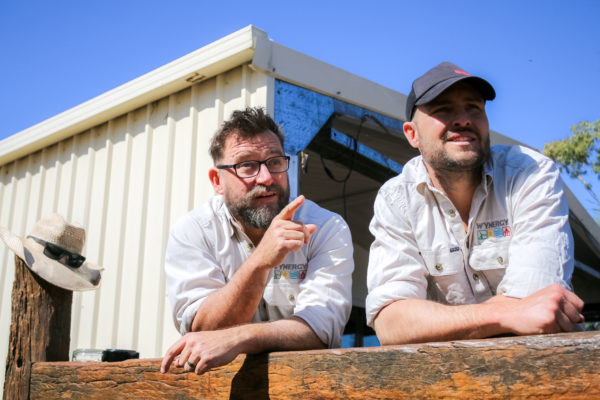From pv magazine Australia.
In drought-stricken Tamworth, in northern New South Wales, part-time high school teacher, earth-moving contractor and experienced PV installer Ben Wynn has for years been planning how to bring agricultural solar power projects – agrivoltaics – to the region.
Wynn and business partner Brad Dolahenty’s company Wynergy will this week unveil Werris Creek – the first of seven 5 MW agrivoltaic solar farms – to investors.
Agrivoltaics concerns spacing solar panel arrays and elevating the modules so as to permit light to reach the ground at a level which supports the growth of crops or forage grasses. Installing shade-giving solar panels also helps retain soil moisture and their elevation accommodates grazing sheep or goats.
Wynergy’s mixed land-use proposition and its guaranteed income for farmers – who will be paid a lease for hosting PV and receive a small initial shareholding in the projects – is proving popular with Tamworth agriculturalists near viable grid connections. Some had previously been approached by solar farm prospectors but had failed to see the value in participating in the renewable energy boom.
Guaranteed income
“So you walk into a farmer’s kitchen and you talk with them about how it can be done using a tracker like Soltec’s SF7, a two-panel, single-axis tracker that’s a little bit elevated and spaced correctly…” began Wynn. “They’ll receive a lease based on megawatts of DC installed and once it’s built we’ll sow the land back to native and subtropical perennials and fence it off and provide water, and they can run sheep or goats and turn a dollar that way as well.”
With landholder agreements in hand, identified grid connection points and regulatory and physical due diligence in place, Wynergy is seeking $500,000 (US$338,000) of private investment to proceed to securing connection and development approvals on the Werris Creek project – named the Menz Solar Farm Company after the Menz family which owns the land.
Wynn expects to “be scratching dirt”, as he puts it, on the first few solar farms by this time next year, with the aim of combining the power output of the seven 5 MW projects with that of a 40 MW development planned for the region as a 75 MW aggregated energy wholesaler.
Ideally, Wynn told pv magazine, “we’ll develop a pipeline of rolling construction that allows us to leverage supply price reductions based on bulk orders of panels and other infrastructure”.
Indigenous workforce opportunities
Some of the land allocated for Wynergy’s solar farms is held by indigenous groups, and Wynn and Dolahenty plan to start training Aboriginal people in the installation and maintenance of solar as the project gathers steam.
“We’ve had some really positive discussions with the NSW [New South Wales] Aboriginal Land Council around a partnership model whereby we will have indigenous branding on power we produce as an aggregator and profit from that company would roll back into the employment programs that support Wynergy Solar Farms,” said Wynn.
Popular content
Wynn and Dolahenty’s expertise in solar installation, business and farming has been honed through the University of New England’s Smart Region Incubator start-up networking service and its AgTech Gateway program. As Wynergy, the partners’ vision is to scale up over the coming decade to a gigawatt of installed solar generation capacity that is enhancing agriculture.

Agrivoltaics has been investigated and implemented in Europe for more than a decade. Over the past year, studies in the U.S. at the University of Arizona and Oregon State University have recorded strong evidence of the benefits to agricultural productivity and solar-module performance of co-located land use.
Resolving land-use tensions
The title of the Oregon State University study, Solar PV Power Potential is Greatest Over Croplands, says a great deal about why there is often tension between clean energy production and agriculture in traditional farming areas, but also heralds the potential benefits.
The study, conducted on “unirrigated pasture that often experiences water stress” at Rabbit Hill agrivoltaic solar farm on the Oregon State University campus, reported a 328% increase in the water efficiency of soils under partial solar panel shading and wind protection. Those more favorable conditions contributed to a 90% increase in biomass growth under the panels.
The microclimate created by transpiration of the biomass beneath the panels also resulted in lower air temperatures around the solar installation, improving module performance.
Wynn said benefits of collocating sheep pasture with solar included reduced eagle strike on lambs. Anecdotal evidence from a farmer running sheep at Glen Innes in a paddock that hosts conventional solar arrays has amounted to a 140% increase in lambing rates.
Conflict
Scientists at Oregon State University stated: “If less than 1% of agricultural land was converted to solar panels it would be sufficient to fulfill global electric energy demand.”
However fear solar generators will displace productive farmland at a time when food security is becoming a worldwide concern has raised barriers to greater renewables penetration.
The prospect of resolving such land-use conflicts has driven Wynn to pursue his vision. “Unless you’re on super marginal country there’s no reason why we shouldn’t be able to build solar farms in a way that provides clean energy generation and agricultural income at the same time,” he said. Wynergy’s aim is to significantly improve agricultural productivity and regional economies as part of a dual process.
This content is protected by copyright and may not be reused. If you want to cooperate with us and would like to reuse some of our content, please contact: editors@pv-magazine.com.



By submitting this form you agree to pv magazine using your data for the purposes of publishing your comment.
Your personal data will only be disclosed or otherwise transmitted to third parties for the purposes of spam filtering or if this is necessary for technical maintenance of the website. Any other transfer to third parties will not take place unless this is justified on the basis of applicable data protection regulations or if pv magazine is legally obliged to do so.
You may revoke this consent at any time with effect for the future, in which case your personal data will be deleted immediately. Otherwise, your data will be deleted if pv magazine has processed your request or the purpose of data storage is fulfilled.
Further information on data privacy can be found in our Data Protection Policy.